The push-up is one of the most popular bodyweight exercises for beginners and advanced trainers alike. But what happens when you add dumbbells to this tried and tested exercise? This post explains what a dumbbell push-up is, how to do it, and why it’s such a good exercise.
A push-up with dumbbells- also called a dumbbell push-up- is a compound chest exercise that works the entire upper body. It requires a person to do a regular push-up. But instead of placing the hands on the floor, the person grips two dumbbells instead.
I was fascinated by this exercise as a beginner myself.
But is it actually effective?
How does it compare with the regular pushup in producing real-life results (i.e. a bigger and more defined chest!)?
I share my research and experience below.
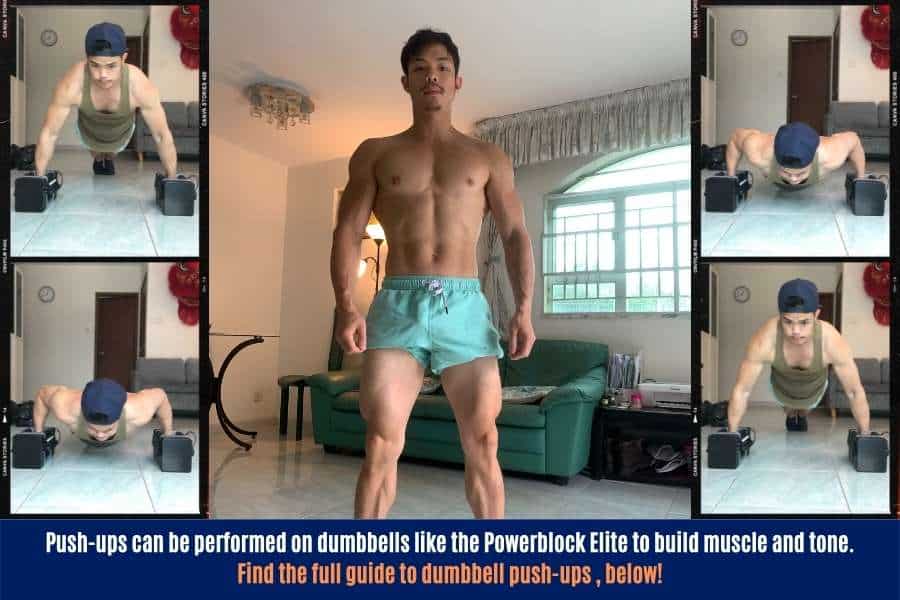
- Which Target Muscles Does A Dumbbell Push Up Work?
- What The Dumbbell Push-Up Does For You
- Differences Between Regular Vs Dumbbell Push Up
- How To Do The Perfect Dumbbell Push-Up
- Are Regular Or Dumbbell Push-Ups Better And More Effective?
- How Many Dumbbell Push-Ups You Should Do
- Results From Doing 100 Dumbbell Push-Ups A Day
- Recap: Why Dumbbell Push-Ups Are Harder Than Regular Push-Ups
- Is It Better To Do Push-Ups Or Dumbbell Chest Exercises
- Conclusion
Which Target Muscles Does A Dumbbell Push Up Work?
Dumbbell push-ups are a compound movement that works the pectorals, triceps, and front deltoids as the primary target muscle. But the biceps, back, core, and glutes are also engaged as secondary stabilizers. Thus, dumbbell push-ups work the full-body, with emphasis on the chest, arms, and shoulders.
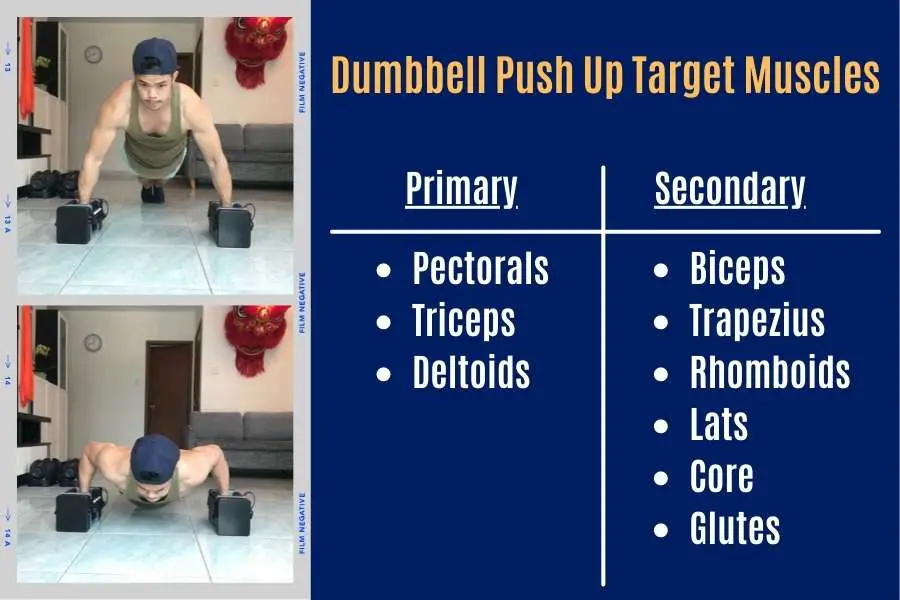
Primary target muscles are those that do the majority of the work in a given exercise.
In the dumbbell pushup, this role is taken by the chest, arms, and shoulders to push you up from the floor.
Secondary target muscles are those that work in the background to stabilize the movement.
In the dumbbell push up, this job is occupied by most of your other muscles to keep your torso sturdy and balanced as you press yourself up and then lower yourself back down.
Therefore dumbbell pushups will work your entire body.
But it’s particularly good for building and toning the V-shaped mirror muscles in the upper body!
You can go to my other article to learn how to use dumbbells and bodyweight exercises in this V-shaped body home workout.
What The Dumbbell Push-Up Does For You
Dumbbell push-ups are a good exercise for building muscle, tone, and burning fat. They are a convenient movement for beginners to start working out at home. The results that can be achieved with dumbbell push ups will vary depending on the workout program and nutrition plan.
Here are the results you can expect from doing dumbbell push-ups:
| Training Result | Dumbbell Push-Up Method | Daily Nutrition |
|---|---|---|
| Build muscle | Straight sets of 10-30 reps | Mild calorie surplus + high protein |
| Increase strength | Explosive sets of 5-20 reps | Mild calorie surplus + high protein |
| Tone, burn fat, and get ripped | Straight sets of 10-30 reps | Mild calorie deficit + high protein |
And here’s how you can achieve your desired training result from dumbbell-pushup training:
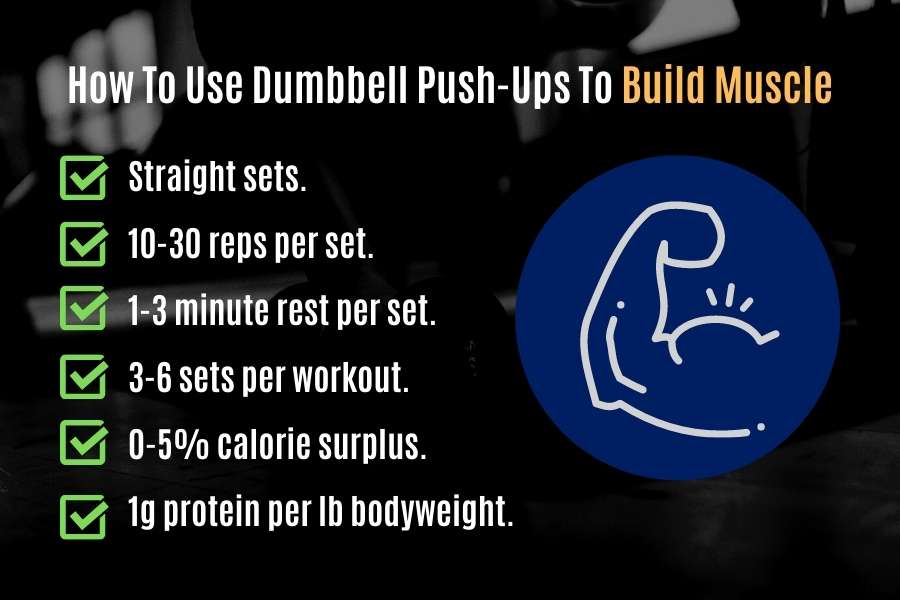
1) If your goal is to use dumbbell push ups to build muscle.
Do straight sets of 10-30 repetitions before taking a 1-3 minute break and starting the next set.
3 to 6 sets per workout are enough.
Beginners who’ve never done dumbbell pushups before should stay on the lower end of the rep/set spectrum, whilst more experienced people can strive for the upper end (and more).
Keep your calorie intake at around 0-5% above maintenance (you can use TDEE calculator to establish how many calories you need) and eat ~1g of protein per lb of bodyweight to build muscle.
As a result, you should be able to gain muscle in the chest, arms, and shoulders.
You probably won’t build a big chest like a bodybuilder, but it’ll be enough to be visibly noticeable!
And if you ARE looking to bodybuild with dumbbells, then you may be interested in checking my full-body bodybuilding program here.
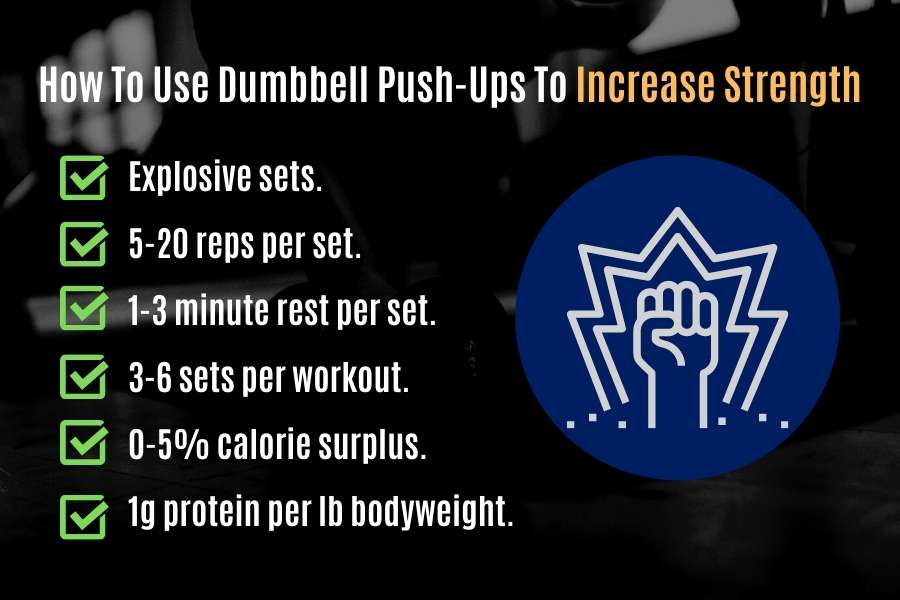
2) If your goal is to use dumbbell push ups increase strength.
Strength and muscle size are correlated. In other words, one usually comes with the other.
But to emphasize strength gains from your dumbbell pushups, you can do the same straight sets detailed above with minor modifications.
Instead of doing 10-30 normal reps, concentrate on 5-20 repetitions of explosive dumbbell pushups.
You can do this by pushing with as much force as possible on the upward phase before lowering yourself down slowly (this can progress into clap push-ups when you are stronger).
Nutrition should be kept similar to what you would eat for building muscle (see above).
This style of push-up is harder so you can expect to do fewer reps compared to muscle-building push ups described above.
But as a result of this plyometric-style training, you’ll build more explosive pushing strength in the chest, arms, and shoulders.
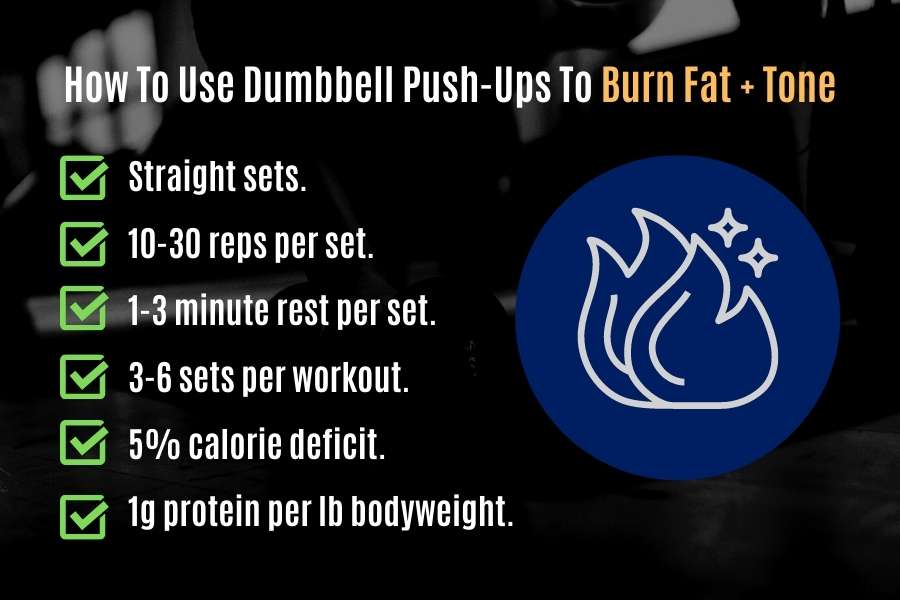
3) If your goal is to use dumbbell push ups to burn fat, tone, and get ripped.
Burning fat, toning, and getting shredded requires a calorie deficit to encourage your body to take energy from your body fat.
Use the same dumbbell pushup workout style as you would for building muscle (see above).
But instead of eating a calorie surplus, you should consume a calorie deficit instead.
Protein intake should remain high to prevent muscle breakdown which could lead to a scrawny physique.
Final result?
You should lose fat and gain/maintain muscle definition in the chest, arms, and shoulders.
And if you get to a low enough body fat, your six-pack abs may even start appearing!
Differences Between Regular Vs Dumbbell Push Up
Exercise difficulty is the main difference between a dumbbell and a regular push-up. Push-ups on dumbbells are generally harder than regular push-ups. This is because the former has a higher range of motion, requires more grip strength, and needs more stabilizer activity to maintain good form.
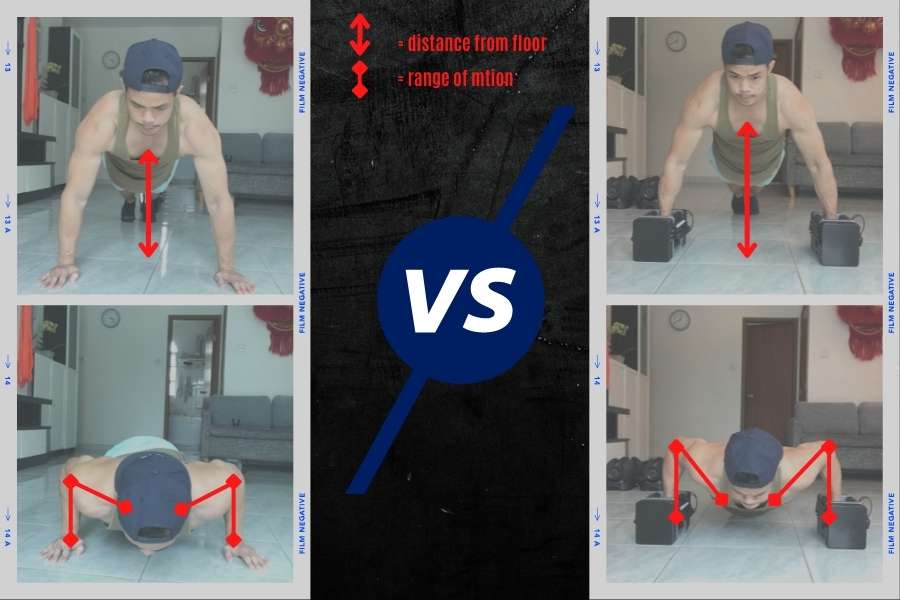
Here’s a summary of the main differences between regular and dumbbell push-ups:
| Regular Push-Up | Dumbbell Push-Up |
|---|---|
| Lower range of motion | Higher range of motion |
| Requires less grip strength | Requires more grip strength |
| Less core abdominal activation | More core abdominal activation |
| Less stabilizer muscle activity | More stabilizer muscle activity |
| Easier to perform | Harder to perform |
- Difference in range of motion. Propping yourself up on dumbbells during a push-up puts you in a deficit position, compared to a regular pushup. This means your chest is raised higher off the ground in a dumbbell push-up compared to a regular pushup. As a result, you can sink lower and get a deeper stretch on the pectoral muscles.
- Requirement for grip strength. Holding a pair of dumbbell handles in a push-up is harder than simply having your palms sit flat on the ground in a regular push-up. As a result, dumbbell pushups require more grip strength compared to regular pushups. Some people also find dumbbell pushups put less strain on the wrist because holding the dumbbell handles forces your wrists to align with your forearms.
- Activation of core abdominal muscles. The raised deficit position in a dumbbell push up forces your abs to work in overdrive as they have to work harder to maintain balance and posture. This means dumbbell push ups can be better for building six-pack abs, compared to regular pushup.
- Stabilizer muscle activity. As per above, the deficit position of a dumbbell push-up means your back, biceps, and glutes have to work harder to maintain balance, coordination, and posture, compared to a regular push-up. Therefore dumbbell pushups are overall better for burning more calories and working the entire body.
- Ease of performance. The above factors combined means dumbbell pushups are overall harder to perform compared to a regular pushup. And this means doing pushups on dumbbells is better than doing a regular pushup for building muscle, tone, and burning fat.
How To Do The Perfect Dumbbell Push-Up
Dumbbell push-ups can be challenging for beginners who haven’t mastered the correct technique.
And doing push-ups with bad form, in general, can reduce benefits as well as increase the risk of injury (particularly in the shoulder joint).
Here’s how to do dumbbell push ups with the correct technique to maximize chest/arm/shoulder activation, build more muscle, and burn more calories:
- Place two dumbbells on the floor at shoulder-width distance. The dumbbells should be parallel and in line with each other. Make sure the floor has grip (use a yoga mat on hardwood floors) and the dumbbells are suitable. The best dumbbells for push-ups have a flat base. The Powerblock Elites are one of the best for push-ups.
- Grip both dumbbells in a forward plank position. Kneel down and grip the dumbbells using a neutral grip (palms facing each other). Now slowly push your feet back to get into a push-up position.
- Distribute weight onto the arms and toes . Your rear weight should be supported by the tips of your toes and your front weight should be supported by your arms. The torso should be angled 30° from the floor but the spine should be kept straight. Looking forward can help you maintain this position.
- Maintain a straight and rigid arm in the start position. Your forearms should be fully flexed, shoulder blades rolled forward, glutes contracted, and core engaged. You’re now in the starting position for the dumbbell push up.
- Keep elbows tucked close towards the torso at all times. This prevents your elbows from flaring out and your shoulders from entering internal rotation (not a good position in any exercise). This in turn will put your shoulders in the best position to avoid stress, pain, and injury.
- Slowly lower yourself down. Don’t let your torso simply drop to the floor. Studies have shown that the lowering eccentric phase is just as important as the pushing concentric phase in a push up. So drop down in a slow and controlled manner to prevent injury and maximise muscle activation.
- Stop when the chest reaches 1-2 inches from the ground. The idea is to get the chest either in line, or even better, just below the dumbbell handles. For most dumbbells, this point is around a couple of inches form the floor. You should feel a stretch in the pectorals but it shouldn’t be uncomfortable.
- Actively use the chest and arms to push upwards. A common mistake is to just push with the arms. Remember, the push up is primarily a chest exercise. So you should actively contract your pectorals. It helps to think about trying to clasp a big box between your outstretched arms as you push up. This can help you with active pectoral contraction.
If you want to add more variety to your workouts, you might also be interested in my other post for more dumbbell push-up variations!
Are Regular Or Dumbbell Push-Ups Better And More Effective?
Dumbbell push-ups are better and more effective than regular push-ups. It is harder to hold a pair of dumbbells during a push-up than it is to do a regular push-up on the floor. However, beginners may find it better to start with regular push-ups before progressing onto dumbbell push-ups.
Here are the benefits of dumbbell pushups and why they are such a good exercise:
- Increased range of motion.
- Higher muscle stretch.
- Increased stabiliser activity.
- More effective calorie burn.
- Better abdominal engagement.
- Requires more grip strength.
- Increased grip strength.
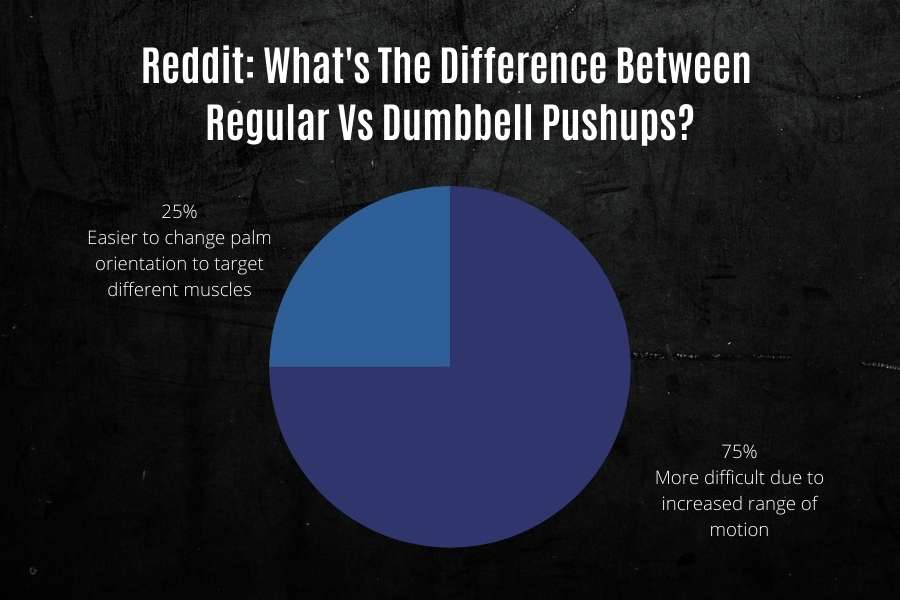
In support of this, 75% of users in this Reddit thread agreed that dumbbell push ups are much harder, but better and more effective, than regular push ups.
And this is mainly due to the increased range of motion (ROM).
The diagram below shows how the ROM differs between a regular vs dumbbell pushup:
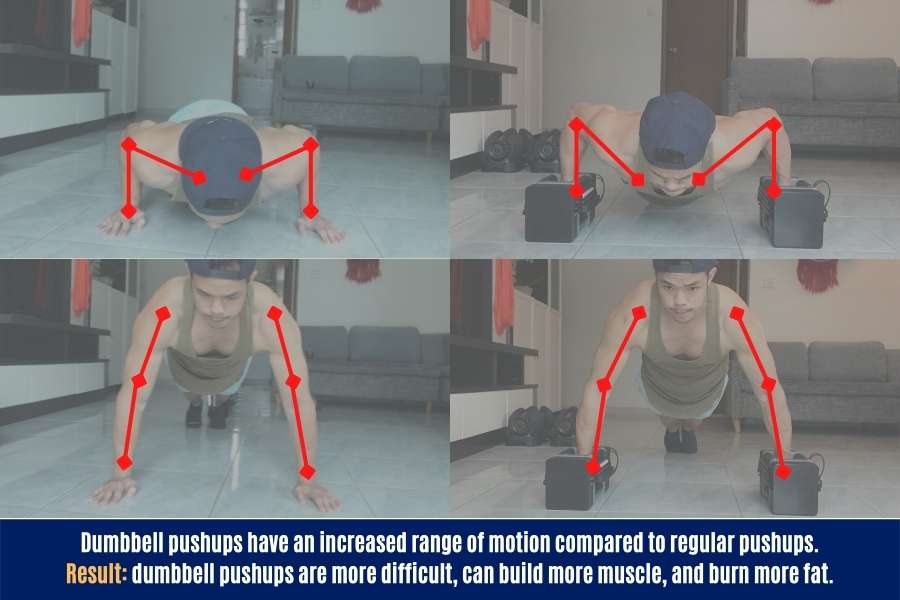
You can see that the chest sinks further down in a dumbbell pushup compared to the regular pushup.
As a result, you get a bigger stretch in the chest muscles.
This 2020 study has indicated that the more your muscles stretch on load (e.g. in a push up), the more effective the hypertrophy response (increased muscle size).
So dumbbell pushups are generally regarded to be better and more effective for building muscle, compared to regular pushups.
Dumbbell pushups also require more stabilizer activity from your core, biceps, back, and glutes.
And greater muscle activity means a more effective calorie burn.
As a result, dumbbell pushups will also help you to effectively burn more fat!
Just be careful as a beginner.
This is a difficult exercise for someone who can’t already do 10+ consecutive bodyweight pushups.
So it would be a better idea for beginners to first master bodyweight pushups before progressing onto dumbbell pushups.
How Many Dumbbell Push-Ups You Should Do
Beginners should start dumbbell push-up training by completing 50 to 100 repetitions per day. This should be separated into 5 to 10 sets with a 1 to 3-minute rest in between each set. Individuals can then increase the number of daily repetitions as they become stronger.
Here’s how many dumbbell push-ups I recommend you do based on your training experience:
| Training Level | Time Practiced For Dumbbell Push-Ups | Recommended Number Of Dumbbell Push-Ups Per Day |
|---|---|---|
| Beginner | 0 to 6 months | 50 to 100 |
| Intermediate | 6 to 24 months | 100 to 200 |
| Advanced | 24+ months | 250 to 350+ |
This is just a rough guideline.
In reality, other factors will affect how many daily dumbbell pushups you should do:
- Previous training history. If you’re a detrained athlete, you’ll likely rebuild your strength very quickly due to muscle memoy. In this case, you should be able to do more pushups than the average person.
- Performing other strength programs. If you’re partaking another strength workout routine, or doing pushups in conjunction with your current weight lifting program, you should do less pushups to avoid overtraining.
- Gender. Men are generally stronger than women and should therefore be able to do more pushups.
- Age. Muscle is lost at roughly 5% per decade after the age of 30. So take 5% of the above numbers for every 10 years you are above 30 to get a rough idea for how many pushups you should be doing for your age.
You might also be interested in my other post to find out how beginners can use push-ups to stop being skinny.
Results From Doing 100 Dumbbell Push-Ups A Day
Doing 100 dumbbell push-ups a day will build muscle and tone in the upper body of the average beginner. However, the results from doing 100 pushups a day will vary greatly depending on training level, discipline, doing the push-ups with good form, and diet.
Here’s what I mean.
I conducted a study putting myself and 2 friends through the 100 pushup-a-day challenge, and recorded the results.
We all have different training backgrounds and lifestyles.
Here’s some background on each person:
- Myself- an intermediate-advanced weight lifter who bench presses 180lbs (80kg) for 8 to 10 reps.
- Friend 1- a high-level soccer player who rarely lifts weights.
- Friend 2- a sedentary beginner who never lifts weights.
Here are the results of doing 100-push-ups a day for each person:
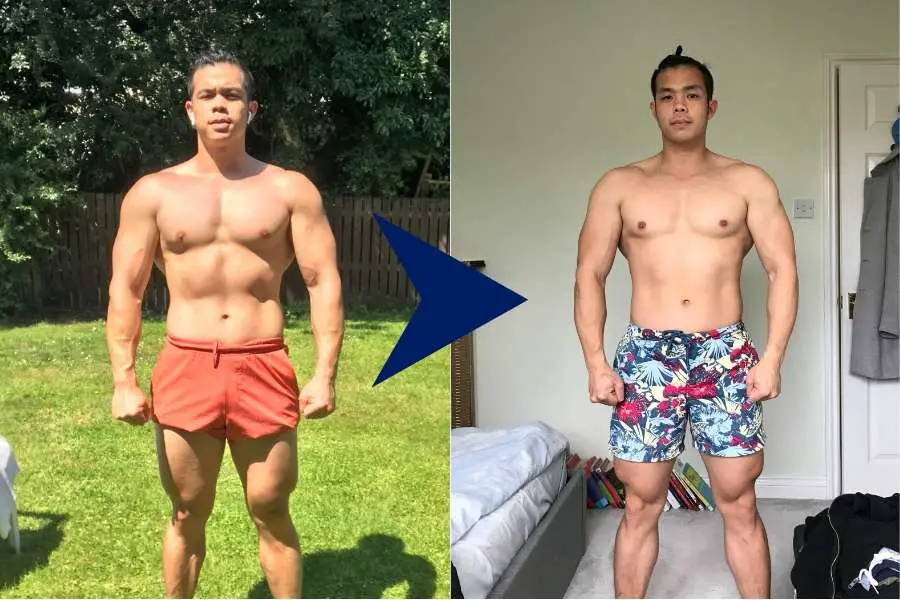
Myself- I undertook the challenge at the peak of my current bulking phase. I subsequently switched to a calorie deficit cut in the hopes of burning fat and toning my muscles. My diet was set at a 5% deficit with a high protein intake. You can see I lost body fat, maintained my muscle, and gained definition.
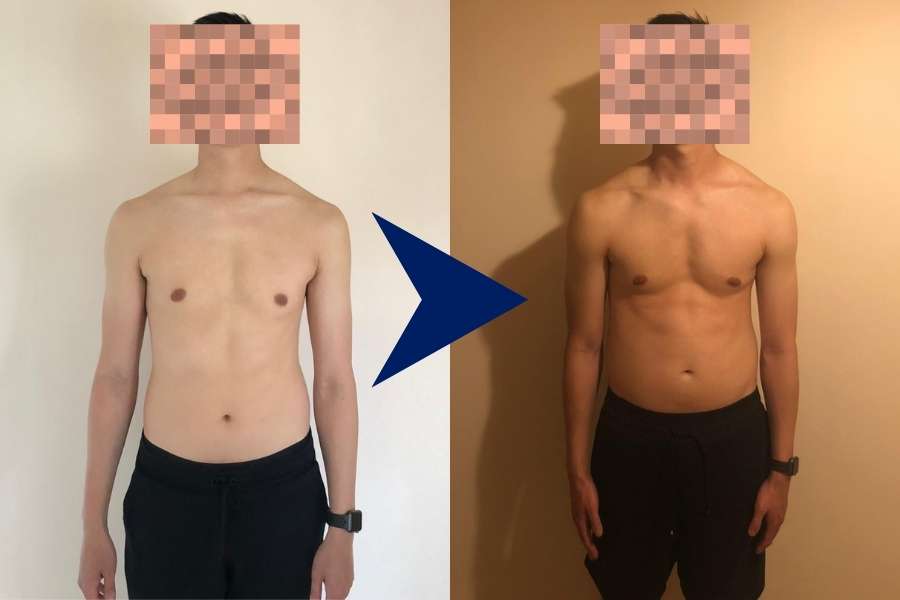
Friend 1- He undertook the pushup challenge without changing his usual diet. Since he was never that “fat” to begin with, we can assume he was eating maintenance calories prior to the challenge. He was also eating around 80g of protein a day which, for him, equates to around 0.5g protein per lb of bodyweight per day. You can see he was able to lose fat, build muscle, add definition in the chest/shoulders/arms, and reveal some of his six-pack muscles.
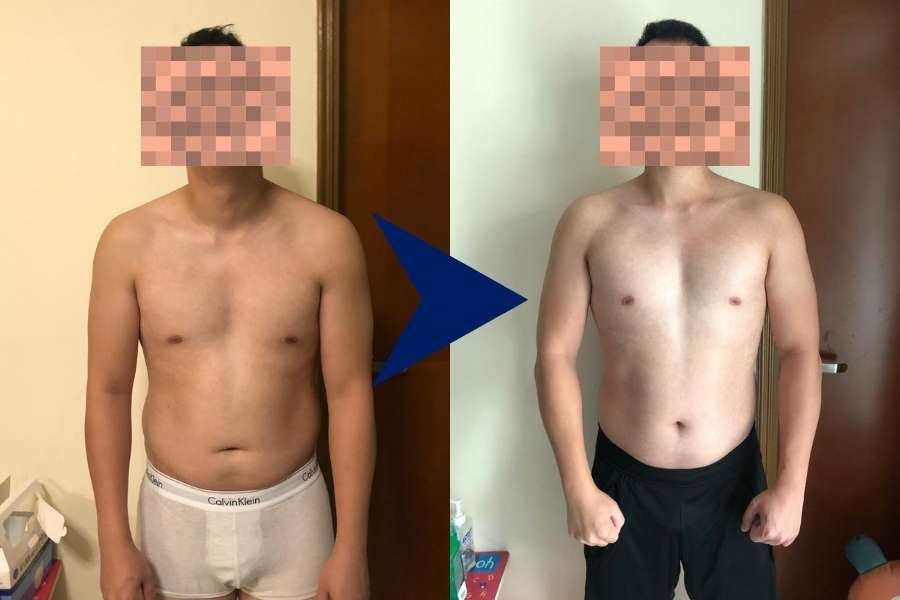
Friend 2- He undertook the push-up challenge without changing his diet which featured fast foods mixed with homecooked foods (i.e. a typical diet for most people). He didn’t take the challenge seriously and missed some days. You can see he still lost fat and gained definition in the abs, arms, shoulders, and chest. I think he could have seen better results by increasing his protein intake.
Bear in mind we were all doing regular pushups.
If you do 100 dumbbell pushups a day on a high protein diet as a beginner, you will likely see even more impressive results since they’re harder!
Recap: Why Dumbbell Push-Ups Are Harder Than Regular Push-Ups
By now you should know why dumbbell push-ups are harder (and more effective) than regular pushups.
If you don’t remember, then here’s a recap:
- Dumbbell push-ups have a higher range of motion. Your chest sinks lower and this puts you in a deficit position.
- Dumbbell push-ups require greater grip strength. You have to grip the dumbbells to maintain balance during the pushup.
- Dumbbell push-ups need greater stabilizer muscle activity. The core, back, biceps, and glutes need to work overtime to accommodate for the deficit position.
These 3 factors combined lead to a harder pushup!
Is It Better To Do Push-Ups Or Dumbbell Chest Exercises
Generally speaking, it is better for beginners to start with pushups before progressing to dumbbell chest workouts. A progression plan could start with bodyweight push-ups that lead to dumbbell pushups. Once the person has gained enough strength, then they can perform dumbbell chest training.
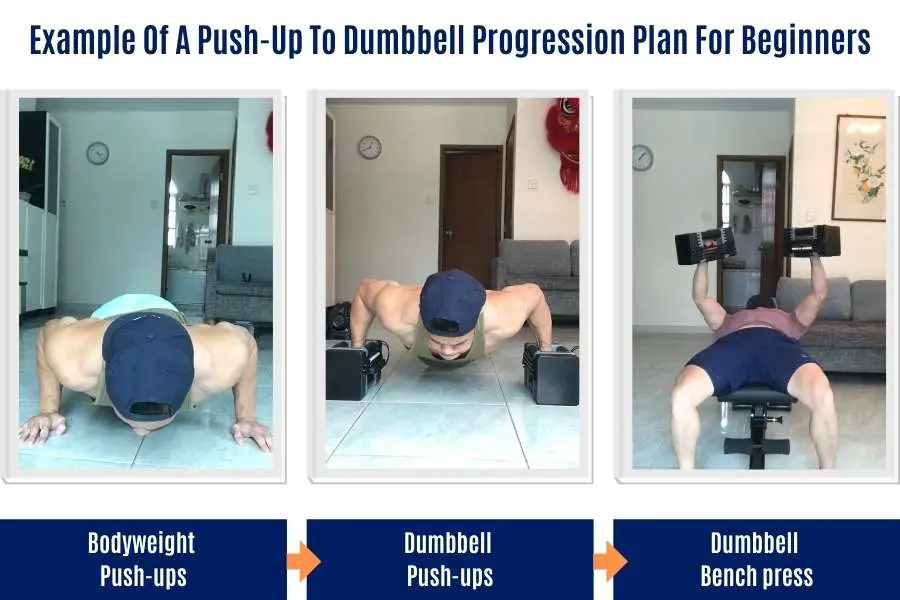
This is a very conservative progression plan.
In reality, you could skip the bodyweight pushups altogether and start with the dumbbell push-ups right away.
Or you could also move directly from push-ups straight into dumbbell chest exercises like the bench press and fly (using a light weight).
Both are OK.
It all depends on your personal preference.
But the general idea is to slowly build your strength in the safest way possible.
It should also be noted that heavy dumbbell chest exercises are generally much better for building muscle and strength compared to pushups.
So if that’s your goal, then you’ll want to move from pushups onto the dumbbell bench presses and flyes ASAP.
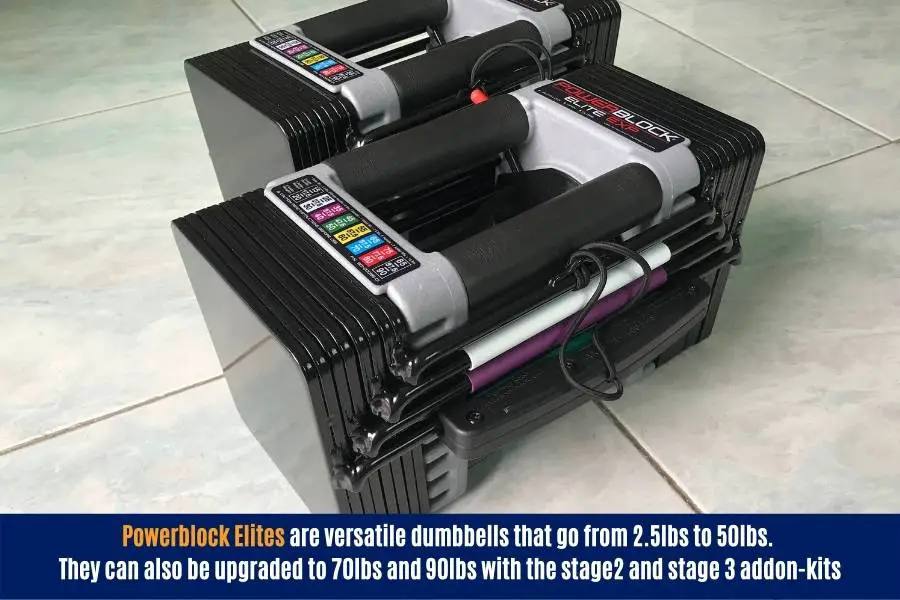
I use and recommend the Powerblock Elite adjustable dumbbells
The Powerblock dumbbells work equally well for both dumbbell pushups as well as bench pressing, chest flyes.
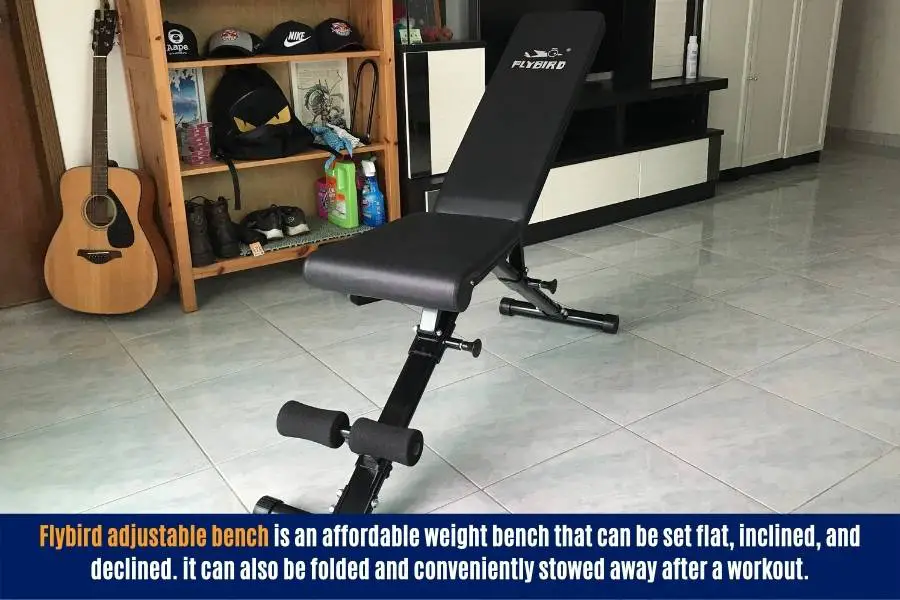
I use the Powerblocks with this Flybird adjustable folding weight bench. Combined, you have everything required to train for a bigger chest.
If you’re interested, then you can find my Flybird adjustable weight bench review here.
Not all dumbbells work well with pushups. For more information, you can check out my other post for a test that examines which adjustable dumbbells can be used for push-ups.
Conclusion
I’ve explained what a dumbbell push-up is, how to do it correctly, and the benefits of doing this type of push up in building a nice chest and upper body.
The dumbbell push-up is a good bodyweight exercise for beginners to advanced lifters alike.
It’s essentially a harder and more effective variation of the popular regular push-up.
As a result, you can expect to benefit from increased muscle and strength gains, as well as a better fat-burning effect!
Just make sure you practice the correct form and choose the right dumbbells.
What do you think of the dumbbell push-up?
Feel free to send me a message if you have any questions! You can find my details on the “contact us” page.
You may also be interested in the downloadable Kalibre Blueprint PDF which details exactly how I gained 40lbs of lean muscle (it’s 100% free!). It details the exact exercises and nutrition (with printable worksheets) I used to go from skinny to ripped!
Thanks for reading guys!
Peace Out,
Kal
(Biochemistry BSc, Biomedical Sciences MSc, Ex-Skinny Guy)


